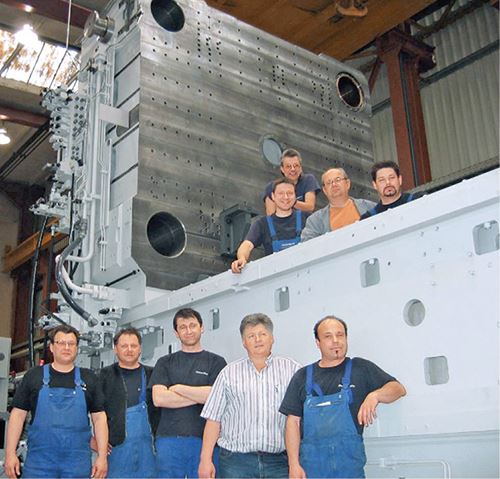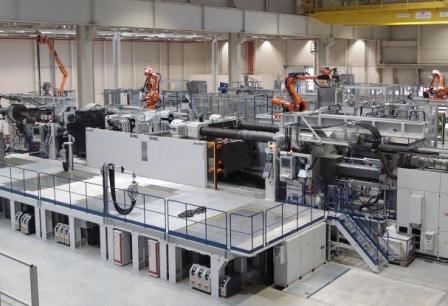More Details on Molding the BMW i3 Electric Car
Massive machines paired up to mold body-shell components.
KraussMaffei AG in Germany (U.S. office in Florence, Ky.) and Engel in Austria (U.S. office in York, Pa.) recently released fresh details on equipment it supplied for molding lightweight components of the new BMW i3 electric car. As reported in our NPE 2012 coverage (July ’12), KM supplied two 4400-ton MX two-platen machines, each with dual turning-stack molds and a six-axis robot, to BMW in Leipzig, Germany. They mold the TPV outer door shell and its substructure in a single pass. The two parts are joined as the stacks turn and bonded with a third plastic component.
This in-mold assembly process is designed to ensure very high dimensional accuracy. In addition to the sidewall panels and rear bumper, the hood is also molded on a KM press. “They are produced on the most complex machines we have every developed,” said Frank Peters, KM v.p. of sales.
In addition, KM’s Reaction Process Machinery unit supplied 20 machines for thermoset high-pressure resin transfer molding (HP-RTM) of composite supporting structures such as the side frame to BMW plants in Leipzig and Landshut. These machines deliver epoxy resin through a mixhead to a closed mold containing dry carbon fibers. This is said to be the first major use of carbon-fiber composites in automotive series production. Compared with previous autoclave or vacuum infusion processes, HP-RTM reduces cycle times from as long as 24 hr to minutes. The process potentially can also use PUR, which is lower in cost, easier to handle, and reacts at lower temperature.
Meanwhile, Engel reports a new order from BMW for two 4400-ton duo two-platen machines for the Leipzig plant. They will be integrated as a double system and will be equipped with two six-axis robots. This giant cell is similar to one that Engel supplied to Leipzig in March 2013 for molding i3 body-shell components. That first cell paired up 4400-ton and 2700-ton duo presses back to back so that two components could be molded simultaneously and assembled with precisely the same "aging" after molding. Those machines also have six-axis robots.
Related Content
-
Materials & Processes: Composites fibers and resins
Compared to legacy materials like steel, aluminum, iron and titanium, composites are still coming of age, and only just now are being better understood by design and manufacturing engineers. However, composites’ physical properties — combined with unbeatable light weight — make them undeniably attractive.
-
Materials & Processes: Resin matrices for composites
The matrix binds the fiber reinforcement, gives the composite component its shape and determines its surface quality. A composite matrix may be a polymer, ceramic, metal or carbon. Here’s a guide to selection.
-
The state of recycled carbon fiber
As the need for carbon fiber rises, can recycling fill the gap?






.jpg;maxWidth=300;quality=90)







